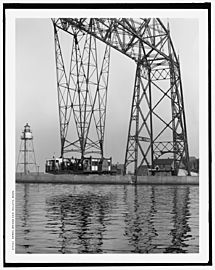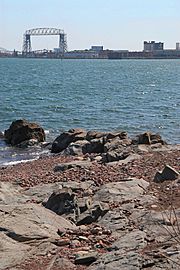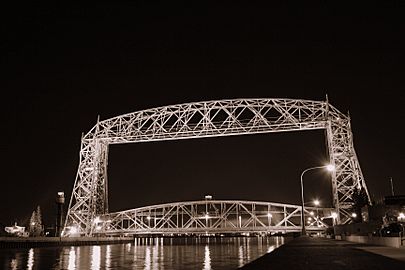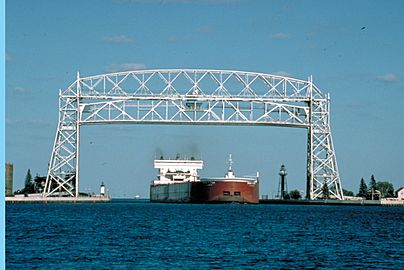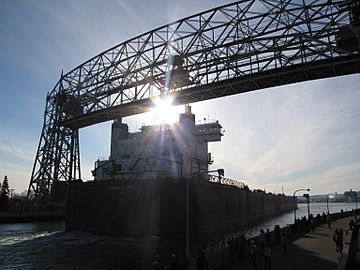Aerial Lift Bridge facts for kids
Quick facts for kids |
|
|
Aerial Lift Bridge
|
|
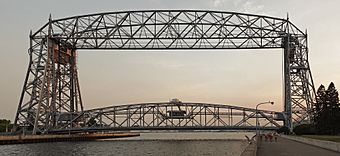
Aerial Lift Bridge in 2007
|
|
| Location | Lake Avenue, Duluth, Minn. |
|---|---|
| Built | 1905, reconstructed in 1929 |
| Architect | Thomas F. McGilvray; C.A.P. Turner |
| NRHP reference No. | 73002174 |
| Added to NRHP | May 22, 1973 |
The Aerial Lift Bridge is a famous landmark in the port city of Duluth, Minnesota. It was first known as the Aerial Bridge or Aerial Ferry Bridge. When it opened in 1905, it was the first "transporter bridge" in the United States. This type of bridge uses a moving platform, like a ferry, to carry people and vehicles across the water. Only one other transporter bridge was ever built in the U.S., called the Sky Ride in Chicago.
Later, between 1929 and 1930, the bridge was changed into a "vertical-lift bridge." This means its middle section can lift straight up to let tall ships pass. This type of bridge is also quite rare. The Aerial Lift Bridge still works today. It was added to the National Register of Historic Places on May 22, 1973. The City of Duluth owns and operates this important bridge.
Bridge History: How Duluth Got Its Famous Bridge
Creating the Canal and a New Island
The Aerial Lift Bridge crosses the Duluth Ship Canal. This canal was dug through a long strip of land called Minnesota Point. Locals often call it Park Point. The canal was built between 1870 and 1871. It created a shortcut for ships to reach the harbor from Lake Superior.
However, digging this canal also meant that part of Minnesota Point became a new island. People living on this island needed a way to get across the water to the main city.
Early Ways to Cross the Water
Finding a good way to cross the canal was tricky.
- Ferries worked during the summer months. But ice made them impossible to use in colder weather.
- A swinging footbridge was also tried. But it was not very strong and felt unsafe.
The city needed a better, more reliable solution for transportation.
The First Bridge Idea: A High-Rise Design
In 1892, a contest was held to find the best bridge design. The winning idea came from an engineer named John Low Waddell. He designed a tall "vertical lift bridge." This bridge would have been about 130 feet (40 meters) wide.
The city of Duluth was excited to build it. However, the United States Department of War (which oversees waterways) did not approve the design. They worried it might block ship traffic. So, the project was canceled. Waddell's design was later built in Chicago, but it was removed in 1932.
A New Plan: The Transporter Bridge
New plans were later made for a bridge that would carry people and vehicles across. This type of bridge is known as an aerial transfer, ferry, or transporter bridge. The first one was built in Spain in 1893. Another was built in France in 1898.
Duluth's bridge was inspired by the one in France. However, the actual way it was built was quite different. The main engineer for Duluth's bridge was Thomas McGilvray.
The Original Aerial Bridge (1905)
When the Aerial Bridge was finished in 1905, it had a special moving platform called a gondola.
- The gondola could carry up to 60 tons (about 54,000 kg).
- It could hold 350 people, plus wagons, streetcars, or cars.
- A trip across the canal took about one minute.
- During busy times, the gondola crossed every five minutes.
Over time, more people moved to Minnesota Point. More cars were used, and tourism grew. The bridge's capacity was not enough for everyone. It was clear that the bridge needed an upgrade.
The Big Change: Becoming a Vertical-Lift Bridge (1929-1930)
A plan was made to change the bridge. The gondola would be removed. Instead, the bridge would have a lifting platform built into its main structure. The company that designed the new bridge was related to Waddell's original company. The new design, which looked a lot like the 1892 idea, is credited to C.A.P. Turner.
Reconstruction began in 1929. To make sure tall ships could still pass, the top part of the bridge had to be raised. This allowed enough space for the new lifting deck. The tall support towers on each side were also changed. They were made stronger to hold new counterweights. These weights help balance the heavy lifting part of the bridge.
The new vertical-lift bridge first lifted for a ship on March 29, 1930.
How the Bridge Works Today
Today, the Aerial Lift Bridge can be raised to its full height of 135 feet (41 meters) in about one minute. It lifts about 5,000 times each year! The main part of the bridge that lifts is about 390 feet (119 meters) long.
When ships pass under the bridge, there's a special tradition. The ship blows its horn, and the bridge blows its "horn" back. The bridge's "horn" is actually two train horns. A common signal is "long-short-short," which is known as the Captain's Salute.
Gallery
Images for kids




